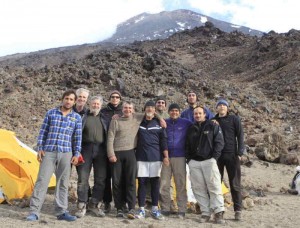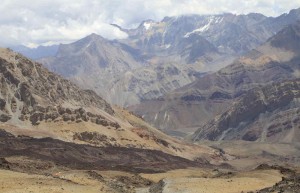UMaine Climate Change Research Team Explores Chiléan Glacier: Blog Three
Click here to see all Climate Change blog entries.
Yesterday we reached the camp at 13,780 feet. It´s a small, flat, sandy area perched on a cliff within the Tupungatito lava flows. The view is spectacular, encompassing the Colorado Valley and many snow-capped mountain peaks. The two peaks that dominate the landscape are Tupungato (about 21,700 feet) and our research site, Tupungatito (about 19,000 feet). During the last few days Tupungatito´s volcanic nature has become more pronounced as its characteristic fumaroles, or smoke emissions, have increased.

The only downside to our camp location is that it lacks easily available water. We are relying on the Arrieros to bring water from our lower camp every couple of days. The plan is to remain in our current location for the next three days, giving us time to acclimate before we head to the next camp at 15,750 feet. During this time the Arrieros and their pack animals will continue to transport our gear to the higher camp. This morning they left with the majority of the snowmobile parts.

Much of the snow that covered the slopes of Tupungatito has disappeared and the last few days of weather have been beautiful with plenty of sunshine. We continually monitor weather forecasts at the higher altitudes to get a better understanding of the conditions we may experience at the drill site on the glacier. The latest forecast we received reported wind speeds atop the mountain will increase significantly over the next few days, increasing from 25 mph to 45mph. On these windier days the windchill factor could drop to minus 26 degrees. Obviously, we hope for calm weather when we reach our drill site, but we have certainly come prepared for rough conditions.
To follow the journey of the Tupungatito research team, click here.
The CCI component of the Tupungatito Expedition is supported by a generous gift from the Garrand Family of Portland, Maine.
